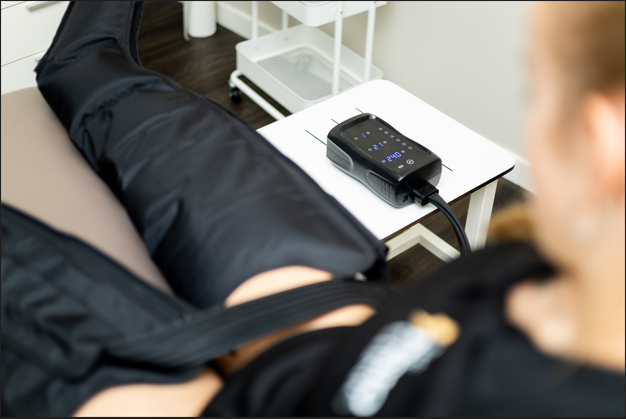
Compression boots enhance blood flow and speed up muscle recovery by applying air pressure to the legs. Ideal for athletes, post-surgery recovery, and chronic pain relief, these boots offer numerous benefits. This article explains how they work and how to use them effectively.
Key Takeaways
- Compression boots enhance muscle recovery by applying targeted pressure, improving blood circulation, and promoting lymphatic drainage.
- Regular use reduces muscle soreness and fatigue while decreasing the risk of complications such as deep vein thrombosis.
- Effective use involves proper session duration, frequency, and consulting a physical therapist, ensuring safety and maximizing benefits.
Understanding Compression Boots
Compression boots are specialized garments designed to enhance muscle recovery by applying pressure to the legs. They consist of inflatable sleeves that wrap around the legs, a control unit that manages pressure levels, and air chambers that provide the compression. Intermittent pneumatic compression in these boots massages the muscles, boosts blood circulation, aids lymphatic drainage, and promotes faster recovery.
Improved blood circulation reduces muscle soreness and fatigue, making these boots invaluable for optimizing recovery.
How Compression Boots Work
The magic of compression boots lies in their use of intermittent pneumatic compression. This technique involves:
- Sequentially inflating and deflating air chambers within the boots
- Helping push deoxygenated blood back to the heart, aiding in recovery
- Enhancing blood flow
- Promoting lymphatic drainage, which is crucial for removing metabolic waste from the muscles
This therapy inflates and deflates chambers in a specific sequence, mimicking the natural muscle pump. It enhances circulation, ensures fresh oxygenated blood reaches muscles, and efficiently removes waste products. Enhanced circulation speeds up muscle recovery, reduces swelling, and alleviates soreness.
Key Components of Compression Boots
Compression boots are composed of several essential components. The inflatable sleeves wrap around the legs, providing the necessary compression to the lower legs. These sleeves contain multiple air chambers that inflate sequentially, targeting specific sections of the leg to maximize effectiveness.
The control unit is the brain of the operation, regulating the pressure and timing of the airflow into the device chambers, ensuring a customized and comfortable experience for the user.
Health Benefits of Using Compression Boots
The health benefits of using compression boots are extensive:
- They apply targeted air pressure to enhance recovery and improve circulation.
- They significantly reduce muscle soreness and fatigue.
- They help decrease the risk of serious conditions like deep vein thrombosis and pulmonary embolism by promoting better blood circulation.
Regular use of compression boots can lead to sustained improvements in overall recovery and athletic performance.
Enhanced Blood Circulation
Compression boots significantly enhance blood circulation, crucial for muscle recovery and overall health. They help remove metabolic waste from muscles and deliver fresh, oxygenated blood, aiding recovery. This is particularly beneficial for endurance athletes and individuals recovering from lower body surgeries, as it helps improve blood flow and reduce the risk of complications like deep vein thrombosis.
Athletes use compression boots to enhance recovery by boosting blood flow and removing metabolic waste after intense workouts. Regular use can improve circulation and muscle recovery, enhancing athletic performance and reducing post-exercise soreness.
Reduction in Muscle Soreness and Tension
Regular use of compression boots offers several benefits:
- Decreases muscle soreness
- Improves recovery times after intense physical activity
- Improves blood circulation
- Reduces post-exercise soreness These benefits make compression boots essential for athletes and fitness enthusiasts.
The optimal time to use compression boots is after intense exercise sessions to kickstart the recovery process. Flushing out metabolic waste from muscles, recovery boots create a healing environment and reduce recovery times.
Consistent use can lead to long-term muscle recovery and performance improvements, provided they are properly cared for.
Lymphatic Drainage and Reduced Swelling
Compression therapy through boots promotes lymphatic drainage by:
- Reducing swelling and fluid retention in the lower limbs
- Aiding the lymphatic system in removing toxins and excess fluids
- Effectively minimizing swelling and edema in the lower extremities
Those with conditions like lymphedema or venous insufficiency can experience relief from swelling and improved circulation using compression boots. Surgical patients, especially those with lower body procedures, may find compression boots helpful in minimizing swelling and promoting healing.
Who Can Benefit from Compression Boots?
Compression boots are utilized by a diverse range of people, including athletes, post-surgery patients, and individuals with chronic conditions, to improve recovery and circulation. Each group uniquely benefits from the enhanced blood flow and reduced muscle soreness these devices offer.
Athletes and Fitness Enthusiasts
Compression boots are increasingly used by athletes to enhance muscle recovery and improve overall performance. These boots enhance athletic performance by improving oxygen delivery to muscles and reducing fatigue and soreness.
Effective use of compression boots leads to faster muscle recovery and better training outcomes for athletes. Enhanced blood circulation and reduced muscle tension make these boots valuable in any athlete’s recovery regimen.
Post-Surgery Patients
Compression boots significantly benefit patients recovering from surgery by:
- Supporting the healing process
- Enhancing blood circulation, which is vital for recovery, especially in the lower body post-surgery
- Promoting lymphatic drainage, significantly reducing swelling in postoperative patients
Better circulation minimizes the risk of complications such as deep vein thrombosis during recovery. Patients using compression boots post-surgery experience reduced pain and faster healing, contributing to increased comfort and mobility during rehabilitation.
Individuals with Chronic Conditions
Those with chronic pain or poor circulation can find relief through compression boots, which alleviate discomfort and enhance blood flow. Compression boots are often effective in alleviating symptoms and promoting blood flow for those suffering from these conditions.
Consulting a physical therapist can tailor compression boot usage to individual medical needs and conditions. Professional guidance ensures safe and effective use of the boots for individuals with chronic health issues.
How to Use Compression Boots Effectively
Compression boots typically consist of adjustable pressure levels, multiple massage modes, and an ergonomic design for user comfort. Users often report faster recovery times and less soreness after workouts, thanks to the improved venous blood flow and the removal of waste products achieved by these boots.
For maximum benefits, follow the manufacturer’s guidelines and adjust pressure settings for comfort.
Session Duration and Frequency
Session duration is crucial for optimizing recovery and preventing discomfort. A typical session should last 20 to 30 minutes to optimize recovery without causing discomfort. Using compression boots once or twice daily is advisable, based on individual comfort and medical guidance.
Most athletes benefit from 20-minute compression sessions, avoiding use beyond 30 to 40 minutes.
Best Times to Use Compression Boots
Post-workout or before bedtime are the most effective times to use compression boots for relaxation and recovery. Using compression boots after workouts aids in removing metabolic waste and promoting blood circulation, enhancing recovery.
Before bedtime, they help relax muscles, reduce tension, and prepare the body for restful sleep.
Safety Tips and Precautions
Consulting a healthcare professional before using compression boots is crucial, especially for those with preexisting medical conditions. Follow the manufacturer’s guidelines to ensure safe usage.
Watch for signs of discomfort or skin irritation and adjust usage as needed. Monitoring the body’s response during and after use helps detect negative reactions, ensuring a safe and effective experience.
Consulting a Physical Therapist
Consulting a physical therapist is crucial for individuals with preexisting conditions to ensure the safe and effective use of compression boots. Athletes and post-surgery patients significantly benefit from a physical therapist’s guidance in using compression boots for muscle recovery and performance improvement.
Monitoring for adverse effects and adjusting usage under professional guidance maximizes the benefits.
Proper Clothing and Setup
Wearing loose-fitting clothing during sessions enhances comfort and effectiveness. Loose clothing prevents constriction and discomfort, allowing better blood flow and highlighting the difference in a more comfortable experience.
Ensuring a comfortable setup with suitable clothing maximizes the effectiveness of customize compression boots.
Monitoring for Adverse Effects
Users should remain vigilant for adverse effects such as pain or discomfort. Consulting a physical therapist is advised for individuals with existing medical conditions to minimize treatment risk.
Wearing loose clothing and ensuring an encouraging comfortable bag cover setup helps connect security and avoid discomfort during light walking sessions, as some may feel unable to display so without proper attire, which can sometimes make them feel uncomfortable.
Integrating Compression Boots into Your Routine
Integrating compression boots into regular wellness practices enhances overall recovery, especially when paired with hydration and nutrition. Consistent use of compression boots, along with proper hydration and a balanced diet, optimizes recovery and improves overall wellness.
Complementary Recovery Practices
Combining compression boots with practices like foam rolling and stretching offers several benefits:
- Improves muscle flexibility
- Reduces stiffness
- Further alleviates muscle tightness
- Enhances overall flexibility
Integrating multiple recovery techniques offers a holistic approach to muscle recovery.
Long-Term Benefits and Maintenance
Proper maintenance, including routine cleaning and dry storage, is crucial for the longevity and effectiveness of compression boots. Consistent use yields long-term benefits in muscle recovery and overall health.
Combining consistent use with good maintenance ensures your compression boots remain effective and beneficial over time.
Summary
Compression boots are a revolutionary tool for enhancing muscle recovery, reducing soreness, and improving overall circulation. Their benefits extend across various groups, including athletes, post-surgery patients, and individuals with chronic conditions. By understanding how to use them effectively and safely, you can integrate compression boots into your wellness routine to maximize their benefits. Whether you’re looking to enhance athletic performance, speed up recovery after surgery, or manage chronic pain, compression boots offer a versatile solution that promotes better health and recovery outcomes.
Frequently Asked Questions
How do compression boots improve muscle recovery?
Compression boots improve muscle recovery by enhancing blood circulation, facilitating the removal of metabolic waste while delivering oxygen-rich blood to the muscles, ultimately reducing soreness and fatigue.
Can anyone use compression boots?
Compression boots can be beneficial for various individuals, including athletes and post-surgery patients; however, it is crucial to consult a healthcare professional if you have any preexisting medical conditions.
How long should I use compression boots in each session?
For optimal recovery, it is recommended to use compression boots for 20 to 30 minutes per session, once or twice daily, based on personal needs.
What are the best times to use compression boots?
The best times to use compression boots are after workouts and before bedtime, as they effectively enhance recovery by removing metabolic waste and promoting muscle relaxation.
What should I wear during compression boot sessions?
Wearing loose-fitting clothing is essential during compression boot sessions to enhance comfort and maximize the effectiveness of the treatment. This choice helps avoid constriction and allows for better circulation.

